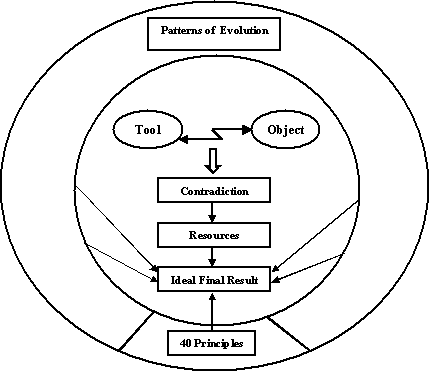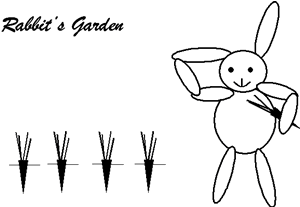
"Where is the Rabbit?"
By Kalevi Rantanen
TRIS OY
Brahenk. 9 E 18
FIN-20100 TURKU, FINLAND
phone/fax +358 2 251 1623
E-mail: kalevi.rantanen@kolumbus.fi
http://www.kolumbus.fi/kalran
Problem solving in business and technology reminds us of the exploration of the unknown continent or planet. We have some background knowledge and maps with outlines. We know that there is something interesting but don't know what. Figure 1 displays the new model for problem solving, that is like the map for the unknown territory. In this paper we will describe the model and demonstrate it with a customer product - candies for children.

Figure 1. The Model for Problem Solving. (From Simplified TRIZ by Kalevi Rantenen and Ellen Domb. Ref. 1. Used by permission.)
The model is based on two areas of knowledge. The first is TRIZ - The theory of inventive problem solving. TRIZ guarantees the efficiency. The second is cognitive psychology. Findings from research on human behavior were used to make the model maximally user-friendly and attractive, and at the same time yet more effective.
1 The Map for Idea Finding
Let's look at Figure 1. The problem is the conflict between a tool and an object, represented by the jagged arrow. The unknown area in the model is the Ideal Final Result. The patterns of evolution and the 40 principles are generic solutions, or templates of ideas, that are useful across a variety of industries and businesses. Thanks to these templates we know a lot about the solutions even before we start the study of the problem.
We can always get some information about existing technology, that is, about old tools and objects. Since we know a lot about the tools and objects and their environment, we can list many resources.
Equipped with all this information we are capable to go to the white area in the map and find the best possible solution, or the ideal final result.
The detailed description of the model and its parts can be found in the new book Simplified TRIZ, Ref. [1].
2 A Candy Story: Rabbit's Garden
Let's now see how the model works. The story begins from a kid's question. We (I and my wife) sit sometimes with a four-year old girl. One day we found candies shaped rather realistically as carrots, and bought them for her.
The kid looked at candies and asked: "Where is the rabbit?"
We decided to make something better for children. We implemented one of the evolution patterns: transition to the macro-level. According to the pattern, the system can be improved by integrating it into the higher-level system or macro-system. It is very convenient to begin from this pattern particularly if there are no explicit problems or contradictions. You can try to improve anything by integrating it with other systems.
The kid had already shown the first step of integration: there should be a rabbit, too. We couldn't, however, find proper "rabbit candies". So we had a contradiction:
�
There should be a rabbit candy with a rabbit's shape (to make it fun for kids)�
There should not be a rabbit candy (to keep the system simple)The solution was simple: Use the picture of the rabbit, instead of an actual rabbit-shaped candy. The innovative principle 26 (copying) gives the same idea.
Something more was still needed: the story. We decided to show a rabbit inspecting the garden with carrots (Figure 2). In the picture she clearly has something to think about, some problem, since she keeps touching her ear.
We prepared a small story, consisting of five sentences: "The rabbit has planted carrots. She waters them carefully. The sun shines and the carrots grow. Now the rabbit is thinking about how to harvest the crop. Can you help her?"

Figure 2. The picture added to the carrot candies. The rabbit inspecting the carrots garden.
Last we selected the name: Rabbit's Garden
Notice also that only easily available resources are needed. No new materials, no new manufacturing technologies.
We prepared a simple "prototype" from paper. We fixed the carrot candies to green paper, and glued this "carrot furrow" on the picture. Now we were ready to show our invention.
The child examined our candy package a moment, and then asked: "Why is the rabbit touching her ear?" We told her the story.
The child helped the rabbit �harvest� the carrots and ate them!
A little later, after playing other games, she song a song of carrots (a popular kid's song obviously learned some time ago in kindergarten)
Later in the same day, in the street, she saw the candy shop and said: "We can go and buy Rabbit's Garden. Then you can help me. You can say, 'let's pull, let's pull' then I pull up carrots". My wife asked, "Will I then pull carrots, too?" The child replied, "No, you should only talk!"
This was the first part of the candy project. We have continued to study this topic and generated lot of ideas and additional solutions.
3 Conclusions
We havestudied shelves in super-markets and candy shops seeking similar solutions. There are carrot candies - without the rabbit. There are candy bags with a beautiful picture, where the rabbit keeps a carrot, but the candies have nothing to do with carrots nor rabbits, and there is no plot or story. There are many other solutions easily generated by TRIZ, but not yet seen on shelves.
The combination of the carrot and the rabbit is so obvious, that it will appear some day. If new ideas are sought by trial and error, much time is needed. If a good model for problem solving is used, this and many other good solutions will be found much more quickly.
References
1. K. Rantanen, E. Domb. Simplified TRIZ: New Problem Solving Applications for Engineers & Manufacturing Professionals, CRC St. Lucie Press, Boca Raton FL USA. 2002. This book will be published in mid-May, and will be available through the Products and Services page of the TRIZ Journal, as well as through on-line bookstores and from the publisher.
|
�
Copyright 1997-2005 CTQ Media LLC |